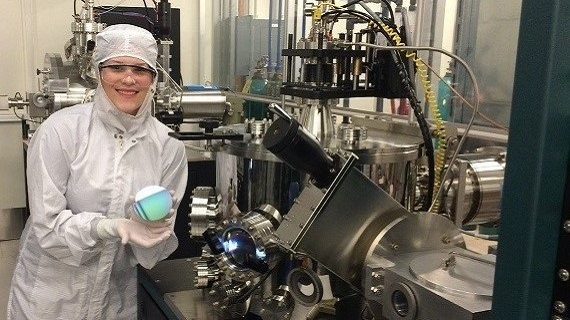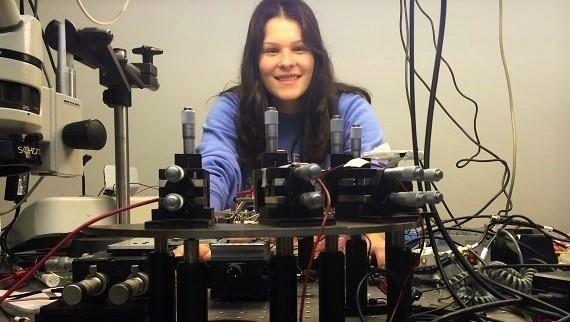Victoria Rosborough's brilliance was evident early on. She became a college student at age 16, bypassing both her junior and senior years of high school. She enrolled in a remarkable learning alternative at Mary Baldwin College (MBC) - their Program for the Exceptionally Gifted (PEG). This all-girls program is part of MBC's residential women's college, which is located in Staunton, Virginia.
After graduating in 2012 with a B.S. in physics, and a double minor in chemistry and mathematics, Victoria continued to excel in graduate studies. She next earned an M.S. in Applied Physics from the University of Oregon. But her sights are set on becoming a Photonics Engineer, and so to that end, she began a Ph.D. in Electrical Engineering in 2014 and is currently a graduate student at the University of California, Santa Barbara. She presented her first conference paper in July at the 2016 Advanced Photonics Congress. You can read it here: Integrated Indium Phosphide Pulse Position Modulation Transmitter for Free Space Communications.
I spoke with Victoria at length, and it was absolutely a no-brainer deciding to include her story in my 2016 blog series of amazing women's college STEM alumnae. Below are selected highlights from our conversation.
What is a Photonics Engineer?
"A photonics engineer designs and builds semiconductor devices that manipulate and route photons to perform a function. For example, a simple photonic integrated circuit (PIC) could consist of a laser and a modulator for generating and transmitting optical signals. Active components on a PIC are controlled electronically, thus integrated photonics is also referred to as optoelectronics. PICs are not as mature as electronic integrated circuits (ICs), so it's an exciting time to be a part of the field. There are many opportunities for startup companies, new designs, and big ideas. For example, to keep up with growing Internet data traffic, many companies and universities are working to integrate an efficient laser on silicon. Silicon is a great material for fabricating ICs, but it's not an efficient light emitter. Many different approaches to integrating lasers on silicon are being pursued and it's not yet clear which technique will become the forerunner."
Why did you decide to skip two years of high school to attend college?
"Around middle school and then into high school, my mom went looking for alternative educational programs because I wanted greater academic challenge and my school system didn't have any gifted or accelerated programs in place. By the time I was in high school, I was taking college-level math and writing courses online through Johns Hopkins University's Center for Talented Youth. Even so, I was still very unhappy at school, so my mom searched for more drastic options and that's when she found The Program for the Exceptionally Gifted (PEG) at Mary Baldwin College (MBC).
My mom and I felt PEG was a good option because I would be learning from professors while belonging to a group of other bright and motivated young women. My parents felt comfortable sending me to MBC at a young age because it is an all-women's college and the younger girls have their own dorm and staff with extra rules such as curfew. As far as I know, there aren't any other programs quite like PEG in the U.S. Even though some traditional colleges may accept outstanding young students when it is a good fit, at PEG I got to learn and bond with other girls in the same boat as me."
How did you decide to major in physics?
"When I began at Mary Baldwin College, I didn't know what to declare as my major. I thought I might study writing and philosophy to become a novelist, but I also liked math and science. I left high school before taking any physics classes and I didn't take general physics in college until my sophomore year. So when I did take physics, it seemed to challenge my thinking differently than other subjects. I really enjoyed the math and problem solving, but I also appreciated the philosophical nature of physics as a tool that can describe everything from subatomic particles to phenomena on the scale of the universe.
By my sophomore year, I knew I wanted to be a researcher, but had no idea what my specialization might end up being. Gradually, I learned about the subfields of physics where I could spend a research career. My adviser in physics, Professor Nadine Gergel-Hackett, taught me about her research with novel electronic devices."
What kind of research were you involved in as an undergraduate student?
"The research I was involved with as an undergraduate revolved around Dr. Gergel-Hackett's work with memristors. I was the first student to work with her after she came to Mary Baldwin College, so I spent a lot of time setting up the lab and characterizing devices fabricated at The National Institute of Standards and Technology (NIST), where Dr. Gergel-Hackett has collaborators.
The goal of my project was to investigate the physical mechanism behind the device switching behavior. I was looking to see if a switch was triggered by applying a certain voltage or by applying current over a set amount of time. The idea was that, if we could demonstrate one case or the other, this would reveal something about what physically goes on in the material itself (titanium dioxide) during a switch.
I presented some background and results at an undergraduate session of the annual American Physical Society (APS) March Meeting in 2012: Electrical Characterization of Flexible Titanium Dioxide Memristors.
I also did an NSF Research Experience for Undergraduates (REU) in the Chemical and Environmental Engineering department at Yale University. Through the REU and conversations with Professor Gergel-Hackett at MBC, I became familiar with some materials and device topics. At this point, I knew I wanted to get an advanced degree after college, but still wasn't quite sure what specialty to pursue."
How did you become interested in integrated photonics?
"After graduating, I found a master's program in semiconductor devices at the University of Oregon. As a part of this degree, I completed a year-long internship at IBM, where I had the opportunity to interact with Ph.D.'s in several areas of IC production expertise. When I applied to Ph.D. programs that year, I sent applications to electrical engineering and materials science departments. It was during this application process that I learned about integrated photonics. Photonics excites me because it's on the cutting edge of research while combining physics and technology.
Along the way, although I wasn't always quite sure where I'd end up, I kept pursuing the types of opportunities that excited me until I found my niche."
Now that Victoria has discovered her niche, I'm positive her career will continue to unfold, as a never-ending adventure steeped in physics.
In my next blog post I'll share with you the awesomeness of Victoria's alma mater, Mary Baldwin College--focusing on how the College for Women is expanding opportunities for their students, as well as other news-worthy announcements. News you won't want to miss, so do stay tuned!
Follow Diane on Twitter @HerSTEMCareer where she celebrates and champions STEM women from around the world. To learn more about women's colleges, visit Diane's blog, Advantages of a Women's College, where a complete listing of all women's colleges in the United States is provided.

